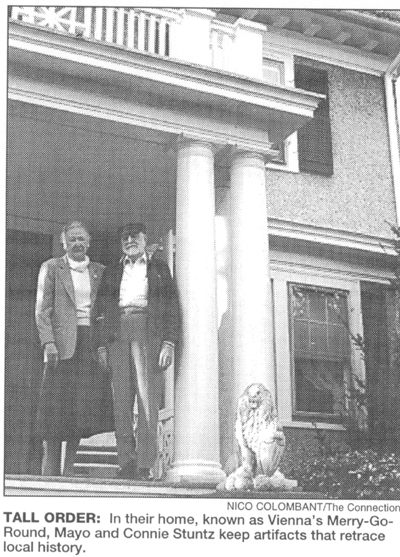
by Nico Colombant for The Connection, December 9-15, 1999
Historiography
In about 500 photographs printed from Shannon's glass negatives and accompanied by excerpts of the rambler's travel articles, the book documents the history of one man's own historical pursuit through Virginia. "After finding something like these beautiful glass negatives, the feeling is, if I don't get this down, I'll lose it," Connie says of her own historical devotion.
 In 1967, Mr. Stuntz was approached by the Columbia Historical Society to buy Shannon's collection of glass negatives from the state of Virginia, which he did for $500. For 25 years, the glass negatives, safekept by Shannon himself for the benefit of historians, sat in boxes on the side porch of the Stuntz's home in Vienna. In Shannon's own words, who referred to himself in the third person, "the heaps of glass sometimes look to him like junk. The tons of negatives interfere with orderly housekeeping, but it is hard to part with them."
In 1967, Mr. Stuntz was approached by the Columbia Historical Society to buy Shannon's collection of glass negatives from the state of Virginia, which he did for $500. For 25 years, the glass negatives, safekept by Shannon himself for the benefit of historians, sat in boxes on the side porch of the Stuntz's home in Vienna. In Shannon's own words, who referred to himself in the third person, "the heaps of glass sometimes look to him like junk. The tons of negatives interfere with orderly housekeeping, but it is hard to part with them."
"This Was Virginia" takes the reader on an early 20th-century travel to the roads, homes, people, battlefields, mills and graveyards of Virginia. The rambler's photos are accompanied by his own texts, which Connie found on microfilms at local libraries. "I would call this achievement a public service and a very important contribution to the history of the region," comments Edith Moore Sprouse, an active local historian. "It also encourages historians to believe new discoveries will keep occurring."
From Washington to Vienna
The order of the book reflects the distance the rambler had to travel from his home in Washington to different parts of Virginia, most often on foot - carrying his camera, supply of glass plates and notebook- so Vienna is in the final chapter.
On a trip to Vienna in July 1917, the Rambler reaches Old Courthouse Road: "This road is so-called because it is the older road leading from Vienna to the village of Fairfax," he writes. "Broad fields stretch away to distant woods. Some of the fields are fruitful with corn and wheat, and some are set off in orchards. Others are white with daisies."
Mayo, who suffers from macular degeneration, was not able to type the manuscript, but as the more outspoken of the two Stuntzes, he is more than willing to talk about the project. "The rambler knew about archeology, geography, stream beds, topography. He was a very worthwhile man". Of his wife, he says: "She has an intense drive to solve problems. She's like a detective."Connie, a 1942 graduate of Duke University, says she is proud to have produced "something that will hold up".